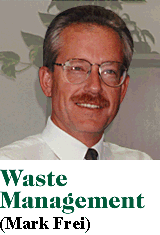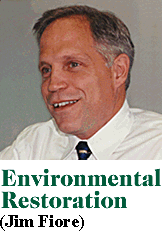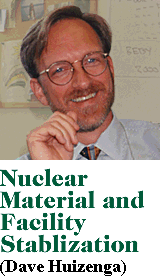

 |
Mark Frei volunteered for and talks with evident enthusiasm about his role of "Mr. Integration" within EM. His is the responsibility for the waste stream disposition maps at the heart of Accelerating Cleanup: Paths to Closure. Armed with input from all the programs, Frei meets regularly with OST's Boyd to agree on strategic science and technology development and deployment activities—which ones get "green," "yellow," or "red" lights in terms of their likelihood of accelerating the overall effort. | |
| Frei is excited about the role of new
technology in the closure of gunite tanks at the Oak
Ridge Reservation. These tanks, which store transuranic
waste from activities at the Oak Ridge National Laboratory
during the 1950s and '60s, are being successfully closed
because of a suite of new technologies including the
Light-Duty Utility Arm; its associated Confined Sluicing
End Effector, a high-pressure water sludge and scale
remover; and the Houdini robot. This last device has
cleaned out the sludge from the Melton Valley tanks and
performed decontamination of tank walls, which was
"not possible a year ago." Opening to page 3-45 of Paths to Closure , Frei shows what can happen when the technology user organizations don't work closely enough with the developers and providers. He notes that earlier in the high-level waste tanks program, the problem of in-tank precipitation wasn't recognized as a high enough risk factor to merit much funding. Consequently, a lot of work on that aspect of the cleanup "has fallen through. As the Paths to Closure document illustrates, EM is preparing critical closure paths for each of its sites that focus on the activities that must be completed for a site to reach its cleanup end state. On these paths, programmatic risk is assessed and shown; this risk includes a technological parameter. One of the areas that the EM program must improve is to better assess programmatic/technological risk and then use this risk information to help formulate a better-prioritized science and technology program. This improvement will help ensure that technology solutions are available to allow completion of a critical activity on the way to site cleanups." Some major unresolved problems remain. The number one problem—or opportunity for science and technology to strut their stuff—is the immense volume of high-level waste in aging tanks: how to characterize it; how to remove the contents, especially the sludge and heels; how to pretreat the waste to minimize the volume to be vitrified; and how to monitor tank contents to ensure the safety of the material. With the cost to put one canister into Yucca Mountain estimated at around $0.5 million, better technology could achieve a life-cycle cost saving in the $10 billion range. Regarding transuranic and mixed waste, Frei sees less of a problem in terms of needs for risk and cost reduction. But opportunities remain for improved characterization tools, especially mobile nondestructive assay tools for small generator sites like Los Alamos and Lawrence Livermore national laboratories. Four FY 1998 Accelerated Site Technology Deployment projects hold the promise of breakthroughs in some of these problem areas. The Improved Systems for Tank Sludge Retrieval, Conditioning, and Transfer, deployed at Oak Ridge, will be used to enhance mixing and mobilization of sludge from various tank configurations and subsequent transfer to intermediate storage tanks and/or treatment facilities. Also at Oak Ridge, Electrochemical Ion Exchange for Contaminant Removal and Waste Reduction combined with Modular Evaporator System for Waste Volume Reduction in Tanks will concentrate liquid radioactive waste prior to immobilization for disposal (see related article). At Richland, Slurry Monitoring involves the deployment of new instruments to reduce the probability of pipeline blockage due to solids segregation, crystallization, and gelation, and therefore unnecessary line replacement costs. Finally, at Savannah River, two AEA Fluidic Samplers will be deployed to obtain accurate and representative samples from sludge feed tanks containing high-level waste. All in all, Frei sees "good things on the horizon." He views the Tanks Focus Area as "a model of connecting the science, the technology, and the users." Asked how he knows OST is listening, Frei points to the National Transportation Program, which recently called on OST to develop special packaging to satisfy regulatory requirements for Pu-238-containing transuranics. He points to the replaceable pour spout insert the Savannah River Technology Center designed, with OST funding, to speed up the process of filling Defense Waste Processing Facility canisters when the original spout tip began to clog. "You hear it from field office people. The ultimate customer is out there, and OST is paying attention. I'm excited," he says, "by the change in focus of the science and technology program over the last one-and-a-half years toward user needs. That's huge. That's not just words." |
||
| Click on each of the (acting) deputy assistant secretaries below to see how OST rates with its customers. | ||
 |
 |